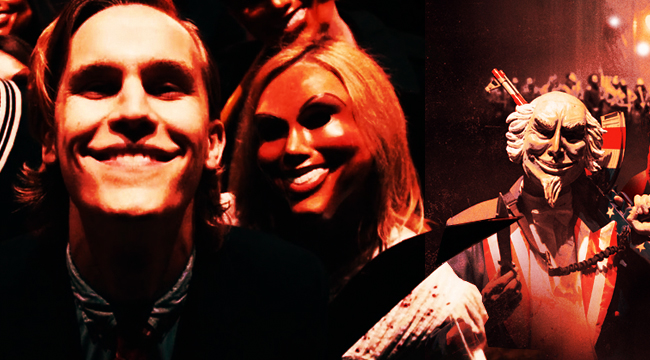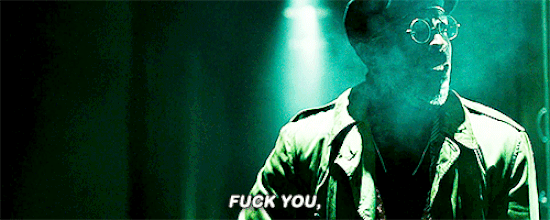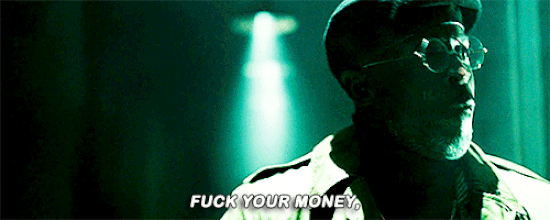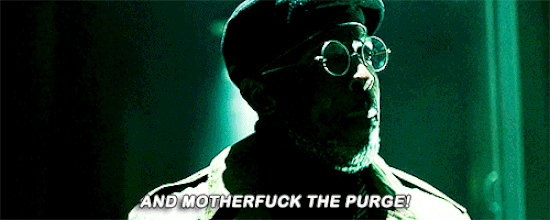
For the uninitiated, The Purge films are based upon a compelling concept — the terrifying idea that, for one night every year, all crime (including murder and rape) is legal in the U.S. This fictional horror began in 2014 when America’s New Founding Fathers (a far-right, totalitarian party) took power amid an economic collapse. The party drove unemployment below 5% and practically eliminated crime, largely due to the annual purge ritual, which commenced in 2018 and allowed people to “release the beast” while emergency services were suspended. The fourth film, The First Purge, arrives on the Fourth Of July, and there’s little reason to expect a poor box-office performance.
In fact, the first three films — The Purge (2013), The Purge: Anarchy (2014), and The Purge: Election Year (2016) — have been insanely successful. Each film scored progressively higher ticket sales (with two grossing over $100 million, globally, on low budgets ranging between $3-10 million) for Blumhouse Productions. And in September, USA Network and Syfy will debut The Purge TV show, which franchise creator James DeMonaco promises will go deeper into the “celebration” as experienced by a yet-undisclosed small city.
Given that the annual purges only go down for eight years (Election Year officially ended them near the conclusion), it’s remarkable that the franchise — which proudly embraces a B-movie aesthetic — has enough fuel for a TV show on top of the four films. Yet producers are pulling this off, while also making impressive inclusion efforts.
1. The Purge Films Succeeded By Satirizing Our Times
As The Purge was originally conceived, the franchise was set in the not-so-distant future, and each sequel has grown even more timely and relevant against the backdrop of contemporary America. The films were never critical successes, and, at times, they suffered from toothless execution. Yet one can’t deny the analogous nature of these onscreen events to reality. Life isn’t exactly mirroring art (yet), but as U.S. politics have grown more combative, and the disenfranchised are driven further away from the so-called American dream, audiences have grown more fond of showing up to see these characters turn the tables, in often violent ways.
The franchise began clumsily in terms of honoring diversity and inclusion, but by the end of The Purge, the female lead held the cards. While showing the purge’s effects on suburbia, the most straight-up horror entry of the series (a twist on the home-invasion subgenre) saw Ethan Hawke (James), Lena Headey (Mary), and family being terrorized by a group of young adults led by a lead villain who channeled James Spader from Pretty In Pink. The yuppie “gang” showed up in pursuit of an unwelcome guest — a wounded black character called the Stranger (Edwin Hodge) — of the family, who had to choose whether to aid the purgers or, you know, act like humans.
The film concluded about as intensely as one would imagine after murder and mayhem aplenty. Mary, a housewife, held court in front of a group of purge-partying neighbors who had entered her home while harboring homicidal resentments and intents. Backed up by the Stranger, Mary slammed a vindictive neighbor’s head into a glass table while declaring an end to the evening’s killing. Thus ended the horrors of that year, but more was to come.
2. The Disenfranchised Went On To Kick Some Serious Ass
Reactions were largely mixed on whether the first The Purge film delivered social justice. However, the franchise hit a crowd-satisfying stride when The Purge: Anarchy took to city streets with Frank Grillo picking up the leading-man mantle as an antihero (known only as The Sergeant) seeking revenge during the sixth purge. As such, the franchise kicked into action mode with Grillo resolutely pursuing his own goals while also finding himself unable to resist helping innocents (victims of home invasions in the projects and those unlucky enough to be trapped outside) who struggled to survive the night.
Obviously, Grillo’s a white male, but he’s still an outsider in that he was breaking purge rules (no vigilante-style rescuing was allowed), for which he could have been executed. Soon enough, it became clear that great forces were involved in allowing wealthy people to outright purchase low-income citizens’ lives, but something more subversive was at play. That is, the female characters refused to become victims, which runs counter to one of the most overused horror tropes. Anarchy took things even further with inclusion, and the film showed marginalized characters fighting to take back power.
Further, Anarchy illustrated how a substantial number of citizens were opposed to the purge. That is, the disenfranchised frequently chose not to purge or only did so while being paid by the rich to round up prospective kills. And notably, Michael K. Williams played Carmelo Jones, the leader of an anti-purge group whose members fought back against the New Founding Fathers and their murderous acts against poverty-stricken citizens perceived to be a drain upon society. Carmelo’s voice was heard in live feeds throughout the film, and he led a group (including the Stranger from the first film) who took mid-purge vengeance upon a group of glitzy purgers bidding in an auction for people’s lives.



Moving onto The Purge: Election Year (promoted with a poster that read “Keep America Great,” which, yes, sounds familiar), Grillo returned with a name, Leo Barnes, and as head of security for progressive Sen. Charlie Roan (Elizabeth Mitchell), who ran for president on a purge-abolishing platform. Of course, the existing political powers hired Nazi mercenaries (bearing “white power” symbols on their military uniforms) to take Roan out, and Barnes worked like hell to protect her. Barnes succeeded, Roan was elected, and the new female president disbanded the annual ethnic cleansing ritual within the U.S. Overall, Election Year took the franchise to eleven with more chaos, more violence, and more in-your-face political mayhem including calling out the NRA.
Throughout the trilogy, the films not only embraced inclusion but also wielded a sociopolitical edge that cannot be denied. And if one considers the venom circulating on social media on a daily basis, is it that much of a stretch that the far-right would support a totalitarian government that would sanction annual mini-genocides?
3. Where Do The Purge And Inclusivity Go From Here?
The franchise’s allegorical comparisons are almost too easy to draw, since some segments of the far-right favor socioeconomic Darwinism. In these films, the rich can much more easily afford to arm themselves and have access to the highest security. They literally pay victims (and in turn, their families) to travel to their mansions and be killed. Election Year ended the purge, supposedly, but the franchise now seeks to take it back to where it all began.
The upcoming TV show shall be set between the beginning of the existing trilogy and The First Purge, for which the trailer heavily plays up the racially charged nature of this annual ritual. The prequel’s heroes largely appear to be minority, so one should expect the franchise to continue its inclusive trend. And why not? Jordan Peele’s outstanding social thriller, Get Out, was the most profitable film of 2017, and Hollywood is finally starting to embrace inclusion after realizing the audience will come.
Will the trend spread? Perhaps, and other franchises are taking note. As an obvious example, the Marvel Cinematic Universe has been taking some steps toward inclusion with the Avengers films. Phase Three finally gave Black Panther his due, and Kevin Feige promises that the MCU will soon add openly LGBTQ characters. And even though Black Widow will probably never see her standalone movie, Captain Marvel will likely lead Phase Four. Yet the MCU took about a decade to get to this point, whereas The Purge films swiftly busted out of the gates with not only inclusive characters but diverse casting. And tellingly, there appears to be no end to the franchise in sight.






